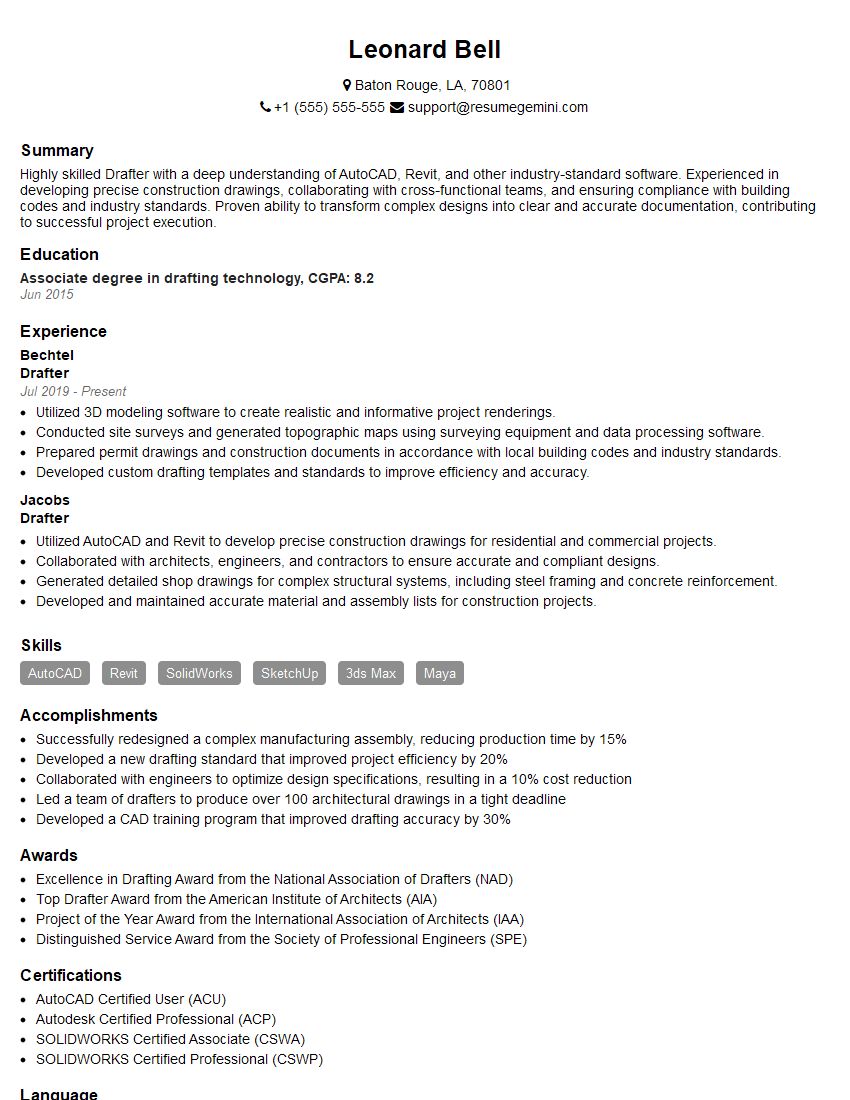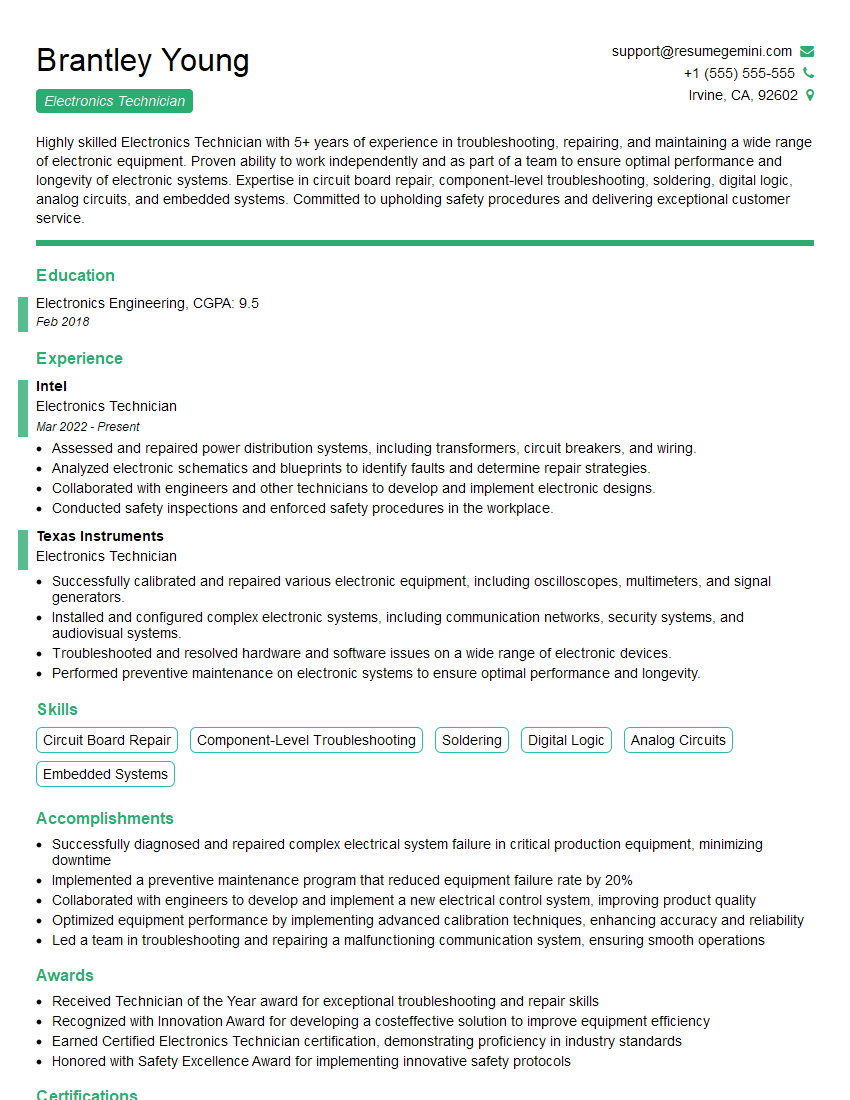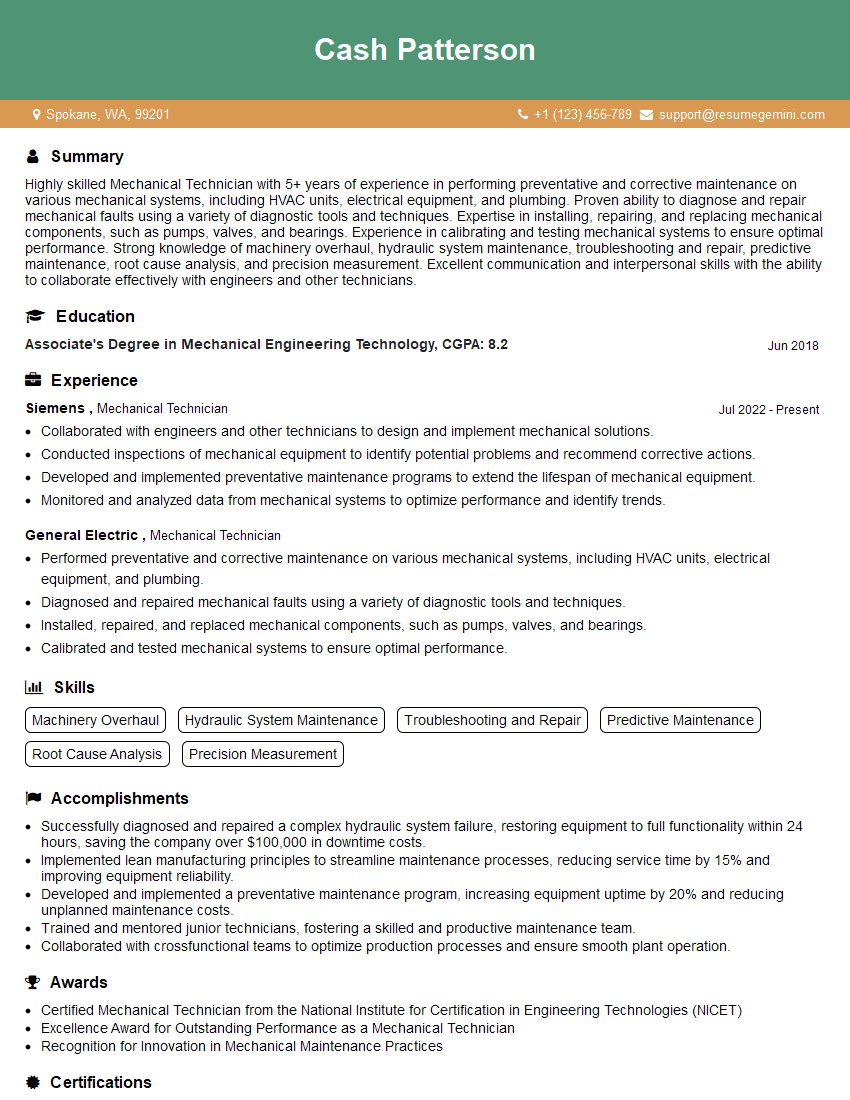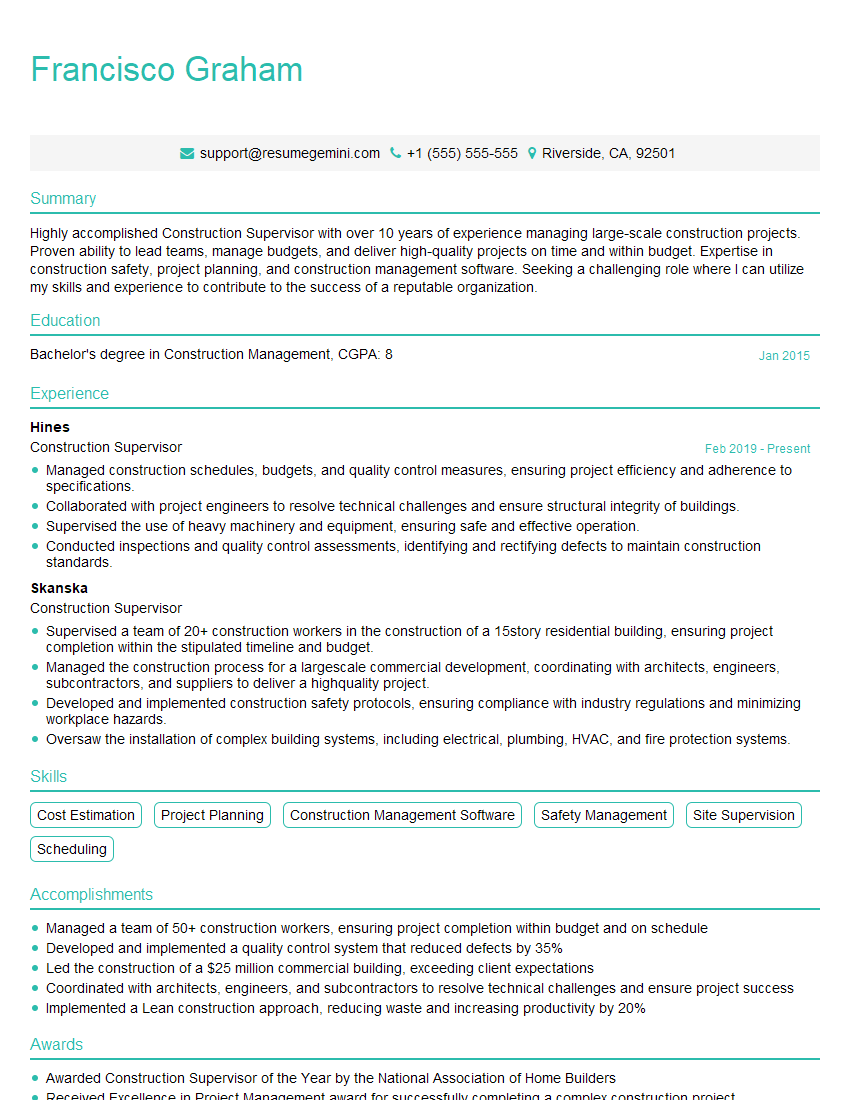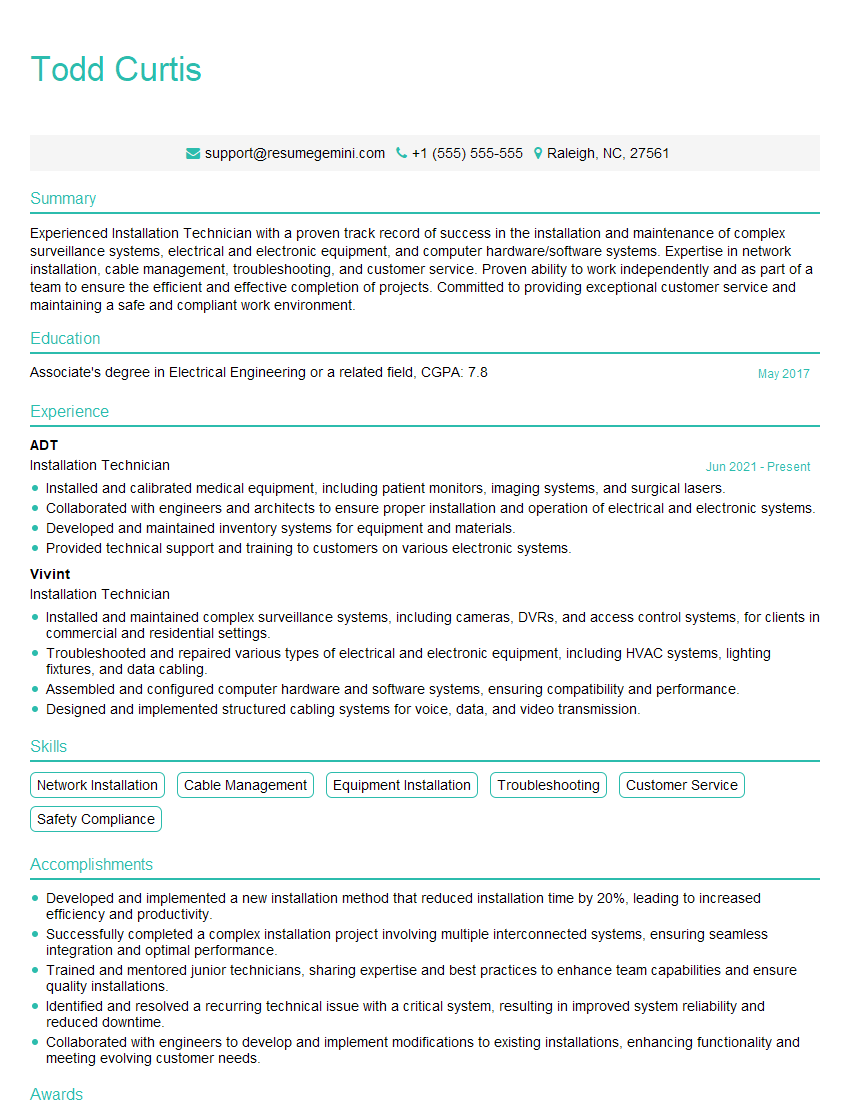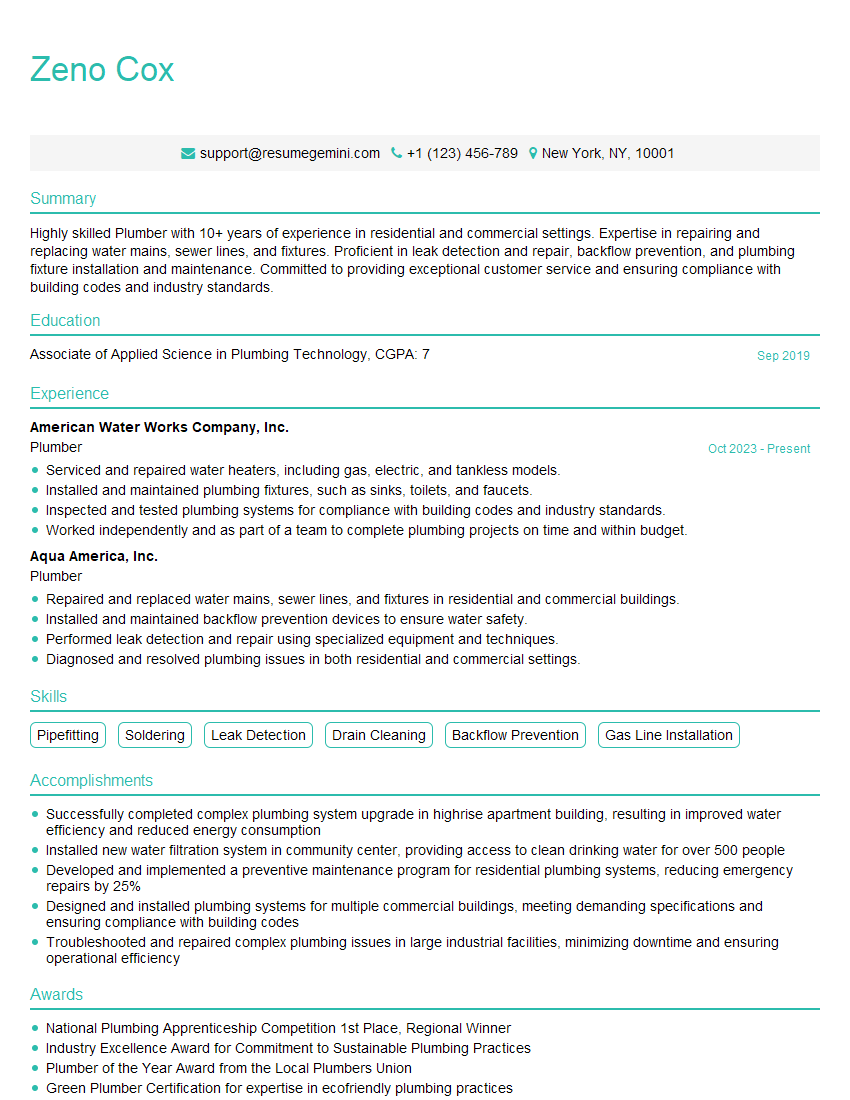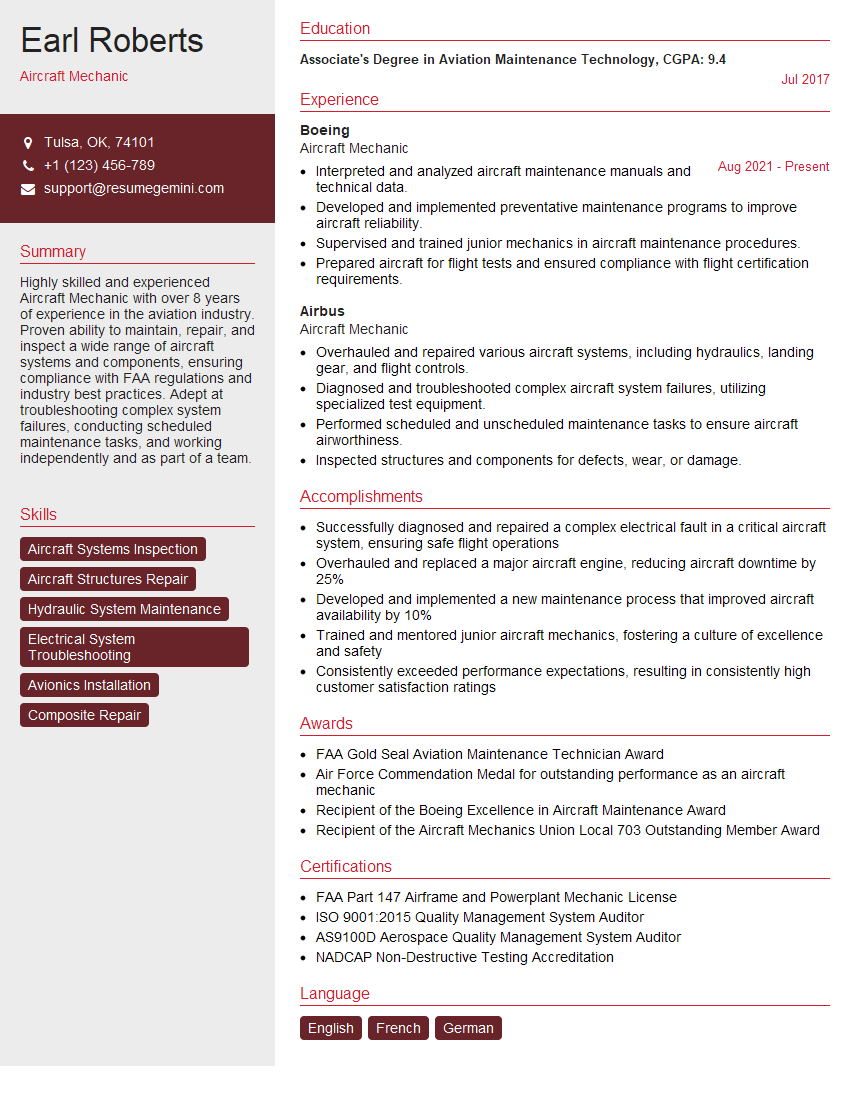Interviews are opportunities to demonstrate your expertise, and this guide is here to help you shine. Explore the essential Ability to read and interpret work orders and technical manuals interview questions that employers frequently ask, paired with strategies for crafting responses that set you apart from the competition.
Questions Asked in Ability to read and interpret work orders and technical manuals Interview
Q 1. Explain your process for deciphering complex technical jargon in a work order.
Deciphering complex technical jargon in a work order is crucial for accurate execution. My process involves a multi-step approach. First, I identify unfamiliar terms and systematically look them up in glossaries, online technical dictionaries, or company-specific documentation. Second, I try to understand the context within the work order. The surrounding sentences and instructions often provide clues to the meaning of the jargon. For instance, if a work order mentions ‘impedance matching’ in relation to an antenna, I know it’s about optimizing signal transmission and will consult relevant resources on RF engineering. Finally, if ambiguity remains, I don’t hesitate to clarify with the relevant engineer or supervisor. It’s far better to ask for clarification than to proceed with a flawed understanding. This proactive approach ensures accuracy and avoids costly mistakes.
For example, encountering ‘PID loop tuning’ in a control system work order, I would consult a control systems textbook or online resources to refresh my understanding of Proportional-Integral-Derivative controllers and the optimization of their parameters before proceeding.
Q 2. How do you handle ambiguous instructions or conflicting information in a work order?
Ambiguous instructions or conflicting information are unfortunately common in work orders. My approach prioritizes safety and accuracy. First, I carefully document the discrepancies, highlighting the conflicting instructions. Next, I attempt to resolve the conflict using my experience and knowledge. Perhaps one instruction is outdated or superseded. If I can’t resolve the conflict through analysis, I escalate the issue to my supervisor for clarification. This ensures we’re all on the same page and prevents potentially costly errors or safety hazards. Consider this scenario: a work order specifies two different voltages for the same component. I’d immediately flag this as a critical conflict needing immediate clarification rather than attempting a guess.
Q 3. Describe a time you identified an error or omission in a technical manual.
During a recent project involving the installation of a new industrial robot, I discovered an error in the technical manual’s wiring diagram. The diagram showed a connection between two components that, if followed, would have created a short circuit. I noticed this inconsistency because I cross-referenced the diagram with the component specifications and noticed a voltage mismatch. I immediately reported the error to my supervisor, providing clear photographic evidence of the discrepancy and suggesting a correction. This prevented potential equipment damage and downtime, showcasing the importance of careful review and validation of all technical information.
Q 4. How do you prioritize tasks when multiple work orders with different deadlines are assigned?
Prioritizing multiple work orders with different deadlines requires a structured approach. I use a combination of methods, including a prioritization matrix. This matrix usually considers factors such as: the urgency (deadline proximity), criticality (impact on production or operations), and complexity of each task. Work orders with imminent deadlines and high impact are given top priority, while less urgent or less critical tasks are scheduled accordingly. Regular review and adjustment of this matrix is necessary to accommodate unforeseen circumstances or changes in priorities. This system ensures that the most crucial tasks are completed on time while maintaining a manageable workflow.
Q 5. What strategies do you employ to ensure complete understanding of a work order before commencing work?
Ensuring complete understanding before commencing work is paramount. My strategy includes a multi-step process: First, I thoroughly read the entire work order, paying close attention to all instructions, specifications, and diagrams. Second, I create a checklist of all steps required to complete the work order. This checklist helps me stay organized and ensures I don’t miss any crucial steps. Third, I cross-reference the work order with any relevant technical manuals or other documentation. Fourth, if any ambiguity remains, I proactively seek clarification from my supervisor or the relevant engineer. Finally, I confirm that I have all the necessary tools, materials, and safety equipment before starting the work. This methodical approach minimizes errors and ensures efficient task completion.
Q 6. How do you utilize diagrams, schematics, or illustrations within technical manuals?
Diagrams, schematics, and illustrations are invaluable tools within technical manuals. They offer a visual representation of complex systems and processes, making it easier to grasp the overall picture. I use them as a primary reference point, often using them in conjunction with written instructions. I trace the flow of signals or fluids in circuit diagrams, pinpoint component locations using assembly drawings, and use exploded views to understand how parts fit together. For example, when troubleshooting a hydraulic system, a schematic shows me the relationship between valves, actuators, and pumps, guiding my diagnostic process.
Q 7. Describe your experience using different types of technical documentation (e.g., flowcharts, tables, etc.)
I have extensive experience utilizing diverse technical documentation formats. Flowcharts are excellent for understanding sequential processes or decision-making procedures. Tables provide a concise way to compare specifications, material properties, or other data points. Data sheets provide detailed information on individual components. I’m adept at interpreting each format efficiently. For instance, a flowchart helped me quickly grasp the startup sequence of a complex machine, while a table of component tolerances ensured accurate part selection during assembly. My ability to interpret these various formats ensures I can fully comprehend and execute complex tasks.
Q 8. How do you handle situations where a technical manual is outdated or incomplete?
Outdated or incomplete technical manuals are a common challenge. My approach is multifaceted. First, I verify the manual’s version and check for updates on the manufacturer’s website or internal document management system. If an update isn’t available, I leverage my experience and knowledge to fill in the gaps. This might involve consulting other relevant documentation, such as previous work orders on similar equipment, online forums for the specific equipment, or even contacting the equipment’s manufacturer directly for technical assistance.
For instance, if a manual lacks specifics on a particular component’s disassembly procedure, I might consult a parts diagram or exploded view drawing. If the information is still unavailable, I’ll proceed cautiously, documenting each step and potentially seeking guidance from a senior colleague before proceeding with any irreversible actions. Safety and thorough documentation are paramount in such scenarios.
Q 9. Explain your approach to troubleshooting a problem based on information from a work order and technical manual.
Troubleshooting using work orders and technical manuals is a systematic process. I begin by thoroughly reviewing the work order to understand the problem’s nature, its symptoms, and any preliminary diagnostics performed. I then refer to the relevant section of the technical manual, cross-referencing diagrams, schematics, and troubleshooting flowcharts. This allows me to isolate the potential root cause.
For example, if a work order details a malfunctioning motor, I’d consult the manual’s electrical diagrams to trace the power supply, check for fuse issues, and examine the motor’s specifications. I might also look for troubleshooting sections addressing common motor problems. I systematically test each component indicated in the manual’s troubleshooting guide, meticulously recording my observations at each step. The process is iterative: I test, observe, analyze, and refine my approach based on the results until the problem is resolved.
Q 10. How do you ensure accuracy when following instructions from a work order and technical manual?
Accuracy is critical. My approach involves several checks and balances. I always double-check component part numbers, settings, and torque specifications against both the work order and the technical manual. I use multiple references whenever possible, comparing information across different sources to reduce the chance of errors. I also work methodically, following instructions precisely, one step at a time.
For instance, before replacing a part, I verify the part number three times: once against the work order, once against the exploded view in the manual, and once against the actual part before installation. This cross-referencing helps ensure the correct part is used. If there are any ambiguities, I always seek clarification from a supervisor before proceeding.
Q 11. Have you ever had to adapt your approach based on discrepancies between a work order and a technical manual?
Yes, I’ve encountered discrepancies. In one instance, a work order indicated replacing a specific pump component, while the technical manual suggested a different, more cost-effective solution that addressed the root cause. The work order was based on initial, superficial observations. After analyzing the manual thoroughly, I presented the discrepancy to my supervisor, explaining both options and their implications. We decided to follow the manual’s recommendation, which resolved the issue permanently and more economically.
Adaptability is key. When discrepancies arise, I prioritize understanding the root cause of the conflict. This often involves carefully scrutinizing both documents, understanding their limitations, and seeking expert guidance when needed.
Q 12. How do you manage your time effectively when working from multiple work orders and technical manuals?
Managing multiple work orders and manuals requires prioritization and organization. I start by reviewing all work orders to identify urgent tasks and their respective dependencies. I then group similar tasks, prioritizing those with overlapping manual sections to reduce time spent switching between documents. I use a task management system to track progress and allocate time effectively. Time blocking and setting realistic deadlines for each task are essential.
For example, I might allocate a specific block of time to working on all tasks related to a particular machine, referencing its manual exclusively during that period. This minimizes context switching and improves efficiency. Regular breaks help maintain focus and prevent burnout.
Q 13. How do you ensure safety when following instructions from a work order and technical manual?
Safety is my top priority. I always begin by reviewing the safety precautions outlined in both the work order and the technical manual. This includes understanding the potential hazards associated with the task, using appropriate personal protective equipment (PPE), and following lockout/tagout procedures when working with energized equipment. I double-check my work at every stage, ensuring that each step is performed safely and correctly.
I always adhere to the ‘if in doubt, stop and seek clarification’ principle. If any procedure seems unsafe or unclear, I immediately halt work and consult a supervisor before proceeding. Safety is non-negotiable.
Q 14. How familiar are you with industry-specific codes, standards, or regulations related to technical manuals?
My familiarity with industry-specific codes, standards, and regulations is extensive. I’m proficient in [mention relevant codes, e.g., NFPA 70E (electrical safety), OSHA regulations, relevant ISO standards for specific equipment]. I understand that these codes are often referenced within technical manuals, and compliance is essential. I make it a point to regularly update my knowledge on these standards to ensure my work adheres to the highest safety and operational standards. My understanding of these standards allows me to interpret the technical manuals more effectively and make informed decisions about safety and compliance.
For example, when working with electrical equipment, I strictly adhere to NFPA 70E guidelines, ensuring proper lockout/tagout procedures and wearing appropriate PPE to mitigate the risk of electrical shock. I document all compliance checks thoroughly.
Q 15. How do you verify the completion of a work order according to the specified requirements?
Verifying work order completion involves a systematic approach ensuring all specified requirements are met. This goes beyond simply finishing the tasks; it demands a meticulous check against the original instructions.
- Review the Work Order: I begin by thoroughly reviewing the work order itself, noting all specifications, deadlines, and acceptance criteria. This might include specific measurements, tolerances, material types, or performance benchmarks.
- Cross-Reference with Technical Manuals: I then consult any relevant technical manuals to ensure the work aligns precisely with manufacturer specifications or industry best practices. This is crucial for safety and ensuring the quality of the work.
- Conduct Thorough Testing: Depending on the nature of the work, this might involve functional testing, performance testing, or visual inspection. For instance, if the work order is to repair a piece of equipment, I would ensure it operates as expected after the repair and meet all performance requirements detailed in the technical manuals.
- Document Everything: I meticulously document each step of the verification process, including any tests performed, results obtained, and any minor deviations (and their resolutions) that occurred during the process. This documentation serves as proof of completion and aids in troubleshooting later if needed.
- Obtain Sign-off: Finally, I would seek approval from the relevant supervisor or client, obtaining their signature or electronic confirmation on the completed work order, acknowledging the satisfactory completion of the work according to the specified requirements.
For example, if a work order details the installation of a specific type of circuit breaker, I would not only install it but also verify the amperage rating, wiring configuration, and proper functionality using a multimeter, and this would all be documented.
Career Expert Tips:
- Ace those interviews! Prepare effectively by reviewing the Top 50 Most Common Interview Questions on ResumeGemini.
- Navigate your job search with confidence! Explore a wide range of Career Tips on ResumeGemini. Learn about common challenges and recommendations to overcome them.
- Craft the perfect resume! Master the Art of Resume Writing with ResumeGemini’s guide. Showcase your unique qualifications and achievements effectively.
- Don’t miss out on holiday savings! Build your dream resume with ResumeGemini’s ATS optimized templates.
Q 16. Describe your process for documenting your work and any deviations from the work order or technical manual.
Maintaining accurate and detailed documentation is paramount. This ensures accountability, allows for future reference, and facilitates troubleshooting if issues arise. My process involves:
- Real-time Documentation: I document my work as I go, noting down key steps, measurements, and observations directly in a designated work log or digital document. This prevents relying on memory, which can be unreliable, especially in complex tasks.
- Deviation Reporting: Any deviation from the work order or technical manual is immediately documented. This includes the reason for the deviation, the steps taken to address it, and the resulting impact. I explain why the deviation was necessary and how it impacts the final product. For instance, if a specific part is unavailable, I’d detail the substitute part used, its specifications, and why it was an acceptable replacement.
- Visual Aids: I often use photographs or videos to supplement my written documentation, especially for complex installations or repairs. These visual aids offer a clear and concise record of the work performed.
- Version Control: If working with digital documents, I utilize version control to track changes and maintain a clear audit trail. This ensures everyone has access to the most current version of the work documents.
Imagine a scenario where a pipe needs to be replaced, but the exact specifications are unclear in the work order. I would document the decision to use a slightly larger pipe (the deviation), explaining the reasoning behind the choice and ensuring it meets or exceeds safety standards. This clear documentation protects both myself and the company from future complications.
Q 17. How do you communicate effectively with colleagues or supervisors regarding work order clarification or discrepancies?
Effective communication is essential for preventing errors and delays. My approach centers on clarity, timeliness, and respect for others’ time.
- Clear and Concise Communication: I ensure my communication is clear and free from technical jargon whenever possible. I strive to explain complex issues in a simple and understandable manner.
- Appropriate Channels: I utilize the appropriate communication channels (email, instant messaging, or in-person meetings) based on the urgency and sensitivity of the issue. For instance, a minor clarification might be done via instant message, whereas a major discrepancy would need a formal email or a meeting.
- Active Listening: I am a good listener, ensuring I fully understand the other person’s perspective before responding. This helps avoid misunderstandings and unnecessary conflicts.
- Documentation: I maintain a record of all communication related to work order clarifications or discrepancies. This documentation serves as a reference point if issues arise later.
For example, if I encounter an unclear instruction in a work order, I won’t proceed blindly. I’ll immediately contact my supervisor, clearly outlining the ambiguity and proposing possible solutions based on my understanding of the technical manuals and the context of the project. I’ll document this exchange via email for future reference.
Q 18. How do you stay updated on the latest versions of relevant technical manuals and software updates?
Staying up-to-date with technical manuals and software is critical for maintaining proficiency and ensuring work quality. My strategy includes:
- Manufacturer Websites: I regularly check the manufacturer’s websites for updates, revisions, and notices regarding the technical manuals and software relevant to my work. Many companies provide email alerts for significant updates.
- Professional Organizations: Membership in professional organizations often provides access to the latest industry standards and software updates through newsletters, conferences, and online forums.
- Internal Systems: Many companies maintain internal systems (intranets, shared drives) containing the most recent versions of technical manuals and software. I regularly check these resources for updates.
- Software Update Notifications: I enable automatic update notifications for all relevant software, ensuring that I always work with the latest versions. This also helps minimize security risks.
Staying updated is not a one-time effort. It’s an ongoing commitment that requires consistent vigilance. This is particularly important in fields with rapid technological advancements, where outdated information can lead to unsafe or inefficient work practices.
Q 19. What is your approach to learning new technical information, whether from manuals or other sources?
Learning new technical information requires a structured and methodical approach. I prioritize understanding the underlying concepts rather than rote memorization.
- Active Reading: I actively read technical manuals, highlighting key concepts, taking notes, and creating summaries. I don’t just passively read; I actively engage with the material.
- Practical Application: I find ways to apply new knowledge through hands-on practice and experimentation. This practical application is crucial for reinforcing learning and building confidence.
- Seek Clarification: If I encounter concepts that are unclear, I actively seek clarification from experienced colleagues, supervisors, or through online forums or training resources.
- Visual Aids: I make use of diagrams, illustrations, and videos to improve my understanding of complex technical concepts.
- Self-Testing: Regularly testing my knowledge helps identify areas where further study is required. This could be through quizzes, practice problems, or simulating real-world scenarios.
For instance, when learning a new software program, I won’t just read the manual; I’ll create test projects, use the help function, and seek help from online tutorials to reinforce my understanding and develop practical skills.
Q 20. How comfortable are you using online resources to complement information found in a technical manual?
I am very comfortable using online resources to supplement information found in a technical manual. Online resources often offer additional perspectives, troubleshooting guides, and community support.
- Validation: Online resources help validate the information presented in the technical manual. They provide a second opinion, helping to ensure accuracy and completeness.
- Troubleshooting: Online forums and communities often contain solutions to common problems that are not explicitly addressed in the technical manual. This can be invaluable in resolving unexpected issues.
- Alternative Explanations: Different online resources might present the same information in different ways, catering to diverse learning styles. This provides a more holistic understanding of the subject matter.
- Community Support: Online communities provide a valuable platform for seeking assistance from other professionals who may have encountered similar challenges.
However, it’s crucial to critically evaluate online resources, ensuring they come from reliable sources to avoid misinformation. I always cross-reference information from multiple sources to confirm its validity.
Q 21. Describe a time you had to interpret a very complex technical manual under pressure.
During a critical system upgrade, we faced a complex technical manual for a newly implemented network infrastructure. The manual was dense, poorly organized, and contained several ambiguous sections. We were under significant time pressure as the upgrade had to be completed within a strict deadline.
To overcome this challenge, I adopted a structured approach:
- Teamwork: I collaborated with colleagues who had different areas of expertise. This allowed us to divide and conquer the complex material more efficiently.
- Break It Down: We broke the manual into smaller, manageable sections, focusing on one critical area at a time. This avoided feeling overwhelmed by the sheer volume of information.
- Visualization: We created diagrams and flowcharts to visually represent the complex processes described in the manual. This helped clarify the steps and dependencies between various system components.
- Cross-Referencing: We used other online resources, such as the manufacturer’s support website and community forums, to clarify ambiguities and find solutions to specific challenges.
- Continuous Communication: We maintained open communication throughout the process, regularly discussing our progress, challenges, and findings. This ensured we remained aligned and could quickly address any roadblocks.
Though stressful, our systematic approach allowed us to successfully navigate the complex manual and complete the system upgrade on time. This experience reinforced the importance of teamwork, structured problem-solving, and the use of supplementary resources when dealing with challenging technical documents under pressure.
Q 22. How familiar are you with different file formats for technical manuals (e.g., PDF, HTML, etc.)?
I’m highly familiar with various file formats for technical manuals. PDF (Portable Document Format) is ubiquitous due to its wide compatibility and ability to preserve formatting. However, it’s not ideal for searching or updating individual sections. HTML (HyperText Markup Language), on the other hand, offers better searchability and the ability to incorporate interactive elements, making it suitable for online manuals and more dynamic content. Other formats I frequently encounter include CHM (Compiled HTML Help), which is a Windows-specific format that creates help files, and XML (Extensible Markup Language), which is useful for structured data and facilitates easier data extraction and manipulation. My proficiency extends to understanding the strengths and weaknesses of each format and choosing the most appropriate one based on the context and intended use. For example, a quick-reference guide might be best in PDF for portability and print readability, while a comprehensive troubleshooting manual might benefit from the searchability offered by an HTML-based system with a robust index.
Q 23. How do you deal with different units of measurement or terminology used in a technical manual?
Handling diverse units and terminology requires a systematic approach. First, I thoroughly review the manual’s introduction or preface to identify the primary units of measurement used (e.g., metric vs. imperial). I then use conversion tools or formulas to ensure consistency. For example, if a work order specifies dimensions in millimeters, and I need to use a tool calibrated in inches, I’ll perform the necessary conversion before proceeding. Regarding specialized terminology, I leverage the manual’s glossary, index, or any provided lexicon. If definitions are unclear or missing, I might consult relevant industry standards, online resources, or subject-matter experts to clarify ambiguous terms before undertaking any task. I always document any conversions or clarifications I made to ensure traceability and prevent errors.
Q 24. How do you effectively utilize indexing, glossaries, or tables of contents in technical manuals?
Indexing, glossaries, and tables of contents are crucial for efficient navigation within technical manuals. I utilize the table of contents to quickly locate the relevant section dealing with a specific procedure or component. The index provides a detailed keyword-based search capability, enabling me to find specific information even if the exact location is unclear. Finally, the glossary helps clarify specialized terms and ensures a common understanding of the terminology used throughout the manual. For instance, while working on a complex piece of machinery, I’d first consult the table of contents for the relevant chapter, then use the index to find specific information about a component, and finally, the glossary to fully understand the terminology associated with that component. I always actively employ all three to maximize efficiency and accuracy.
Q 25. Describe a time you encountered a challenging work order and how you successfully completed it.
In a previous role, I faced a challenging work order involving the repair of a specialized robotic arm on a production line. The work order lacked detailed diagrams, and the technical manual was incomplete and referred to obsolete components. My approach was systematic: First, I carefully reviewed the available documentation and cross-referenced the information with the actual machinery. Second, I used photographic documentation to supplement the inadequate diagrams. Third, I contacted a colleague with experience on similar robotic arms for advice and clarification. This combined approach, involving meticulous observation, diligent research, and effective teamwork, enabled me to identify the faulty components and successfully complete the repair, bringing the production line back online ahead of schedule.
Q 26. How do you identify potential safety hazards while following instructions from a work order and technical manual?
Identifying safety hazards is a paramount concern. I meticulously review the work order and technical manual for explicit safety warnings, precautions, and required Personal Protective Equipment (PPE). This includes paying close attention to sections addressing potential hazards like high voltage, moving parts, hazardous materials, and confined spaces. I also consider implicit safety risks – those not explicitly stated. For example, if a procedure requires working at heights, I’d identify the need for fall protection, even if it isn’t explicitly mentioned in the instructions. I always follow the safety regulations and company procedures, and if any doubt arises, I seek clarification from a supervisor or safety officer before proceeding. Safety is non-negotiable; I always prioritize it over speed or efficiency.
Q 27. How do you contribute to continuous improvement regarding the clarity and effectiveness of work orders or technical manuals?
Continuous improvement in work order and technical manual clarity is vital. My contributions involve providing feedback on identified ambiguities, suggesting improvements to the clarity and organization of procedures, and recommending the addition of visual aids like diagrams or flowcharts to complex processes. I document all feedback systematically and propose solutions with evidence. For example, if I encounter a vague instruction, I suggest rewording it for better comprehension. If a diagram is missing, I propose its creation. By actively participating in the improvement cycle, I strive to make technical documentation more accessible, efficient, and safer for everyone. The goal is to create documents that are not only easy to understand but also reduce the potential for errors and accidents.
Key Topics to Learn for Ability to Read and Interpret Work Orders and Technical Manuals Interview
- Understanding Work Order Structure: Learn to identify key components like job descriptions, required materials, safety procedures, and deadlines within work orders. Practice deciphering abbreviations and specialized terminology.
- Interpreting Technical Drawings and Diagrams: Develop the ability to read schematics, blueprints, and other visual representations of systems or processes. Practice identifying components, connections, and measurements.
- Following Step-by-Step Instructions: Master the skill of meticulously following procedures outlined in technical manuals. Practice identifying critical steps, understanding sequence, and recognizing potential hazards.
- Troubleshooting and Problem-Solving: Develop strategies for identifying and resolving discrepancies between work orders, technical manuals, and actual situations. Learn to utilize troubleshooting guides effectively.
- Identifying and Applying Safety Procedures: Thoroughly understand and be prepared to explain safety regulations and precautions related to specific tasks as outlined in work orders and manuals. Practice identifying potential safety hazards.
- Effective Communication Based on Documentation: Practice articulating your understanding of work orders and manuals to others, demonstrating clear and concise communication skills.
- Using Reference Materials Effectively: Develop efficient strategies for locating and utilizing information from various sources (manuals, online databases, etc.) to complete tasks accurately.
Next Steps
Mastering the ability to read and interpret work orders and technical manuals is crucial for career advancement in many technical fields. It demonstrates attention to detail, problem-solving skills, and a commitment to safety – highly valued attributes by employers. To increase your job prospects, create a compelling and ATS-friendly resume that highlights these skills. ResumeGemini is a trusted resource to help you build a professional resume that showcases your abilities effectively. Examples of resumes tailored to highlight expertise in reading and interpreting work orders and technical manuals are available through ResumeGemini to help you craft your perfect application.
Explore more articles
Users Rating of Our Blogs
Share Your Experience
We value your feedback! Please rate our content and share your thoughts (optional).
What Readers Say About Our Blog
This was kind of a unique content I found around the specialized skills. Very helpful questions and good detailed answers.
Very Helpful blog, thank you Interviewgemini team.







